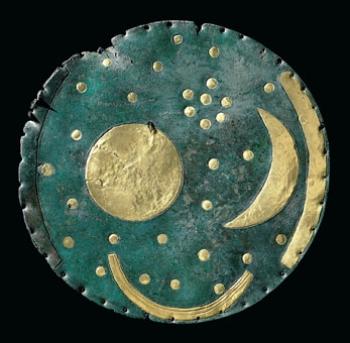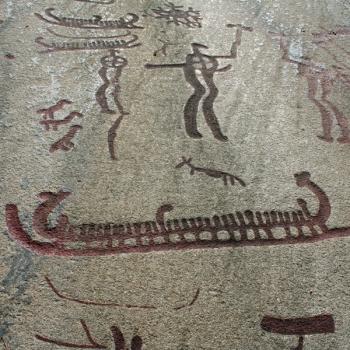‘2012BC: Cornwall & the Sea in the Bronze Age’ at National Maritime Museum Cornwall
Source -http://www.nmmc.co.uk/index.php?/whatson/news/2012bc_cornwall_and_the_sea_in_the_bronze_age_at_national_maritime_museum_c/

Nebra Sky Disc © State Office for Heritage Management and Archaeology Saxony-Anhalt, Juraj Lipták
National Maritime Museum Cornwall invites you to step back in time, to over 4500 years ago, in a new exhibition called 2012BC Cornwall and the Sea in the Bronze Age.
Opening on Friday 13 April, the new six month exhibition offers the opportunity to witness a live reconstruction of a prehistoric boat, supported by rare objects never before seen in the UK.
A first for the Museum, and a first for experimental archaeology, the new exhibition unlocks Cornwall’s prehistoric maritime heritage, showcases ancient Cornwall’s civilisation and confirms the county’s importance within trading Europe at that time.
With objects on loan from the British Museum, Royal Cornwall Museum and the Landesmuseum fur Vorgeschichte in Germany, National Maritime Museum Cornwall has secured a number of artefacts for the exhibition which are significant in changing our perceptions of prehistoric Europe.
The Nebra Sky Disc, the oldest representation of the cosmos anywhere in the world, has changed our understanding of history. The original is on display in the Landesmuseum fur Vorgeschichte in Germany and it, and its master copy, has never been on display anywhere else before, until now. The master copy is now at the Maritime Museum as part of the 2012BC exhibition.
Breathtakingly beautiful, this ornate bronze disc, 30cm wide with a blue-green patina and inlaid with gold symbols interpreting the sun, moon, stars and a boat shows a conception of the world that could never before have been imagined in prehistoric Europe prior to its discovery.
The gold on the disc has been identified as Cornish, coming from Carnon Down mines, and the tin from elsewhere in the county and couldn’t be a more powerful item to show how well connected Cornwall was in the European world, 4500 years ago.
The beginning of the Bronze Age in Britain can be put around 2500BC. Although not certain, it is generally thought that the new bronze tools and weapons identified with this age were brought over from continental and Irish sources. And, a number of the objects on display, including a dagger from Greece, found in Cornwall, is certainly evidence of this.

True Bronze is a combination of 10% tin and 90% copper, both materials readily found in Cornwall. Some tin and copper ingots, recently discovered on a wreck in Salcombe in 2009 and on loan from the British Museum, add to the Maritime Museum’s collection of ‘never before seen objects.’ Impossible to date, because they are a metal, they were found on a wreck with other Bronze Age objects and as a consequence are thought to be the first evidence in the UK of metals being transported by boat.
Central to the exhibition is a recreation of the oldest constructed boat ever found in Western Europe. The prehistoric boat will be built to scale using replica tools, such as bronze axes. The Bronze Age sewn-plank boat is unique to England and Wales and will be stitched together with yew tree fibres and use moss as caulking, to stop the boat from leaking.
The project aim behind the live reconstruction of the 16m long boat, made of oak, is to find out more about the processes behind building a sewn boat, to examine the seaworthiness of such vessels and to understand how it was built and sailed.
Joining forces with Professor Robert Van de Noort from the University of Exeter, one of the world’s leading experts in Bronze Age period sewn-plank boats and archaeologists and engineers at the University of Southampton and Oxford Brookes University, National Maritime Museum Cornwall is very proud to be developing and hosting the exhibition.
Jenny Wittamore, Assistant Curator at National Maritime Museum Cornwall says: “There are outdated perceptions of the Bronze Age, which have masked the true age and depth of Britain’s maritime heritage, and of the active role played by Cornish and British Bronze Age communities connecting to the wider world. This exhibition celebrates prehistoric innovations in ship building and Cornwall’s role in European integration using investigative archaeology that the public can get involved with.”
“We’re very excited about it and honoured to be part of this ground-breaking work and look forward to our visitors re-discovering Cornwall’s Bronze Age past.”
'2012BC Cornwall and the Sea in the Bronze Age' opens at National Maritime Museum Cornwall on 13 April and runs until 30 September 2012. A number of academic lectures will be supporting the exhibition and further information on these will be available shortly.